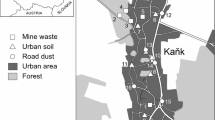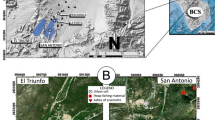Abstract
We determined the amount of bioaccessible lead in samples of contaminated soils and in mining and refining wastes collected in the surroundings of a former smelter in a rural area in south-eastern Brazil. Previous studies showed that some resident children and adults had blood Pb levels above recommended limits, but the contamination route was not established. The incidental ingestion of contaminated soils and dusts is considered to be a major route of lead uptake by humans. Bioavailability of heavy metals like Pb depends on solubility during digestion. We used in vitro tests that simulate human gastrointestinal (GI) media to measure the amount of soluble Pb under such conditions. Pb in soil and solid waste samples ranged from 0.03 to 4.1% and 1.2 to 15%, respectively. On average, 70% of the lead content was soluble in three different simulated gastric solutions (pH 1.5 and 1.7). For the same samples, lead solubility decreased to 2–22% when the pH was raised to pH 7 to approximate conditions found in the small intestine. These results indicate that if soils and dusts of the area are ingested, most of the lead will dissolve in the stomach, and part of it will remain soluble in the duodenum, i.e., would be potentially available for absorption. These findings may explain the high blood Pb levels previously reported.








Similar content being viewed by others
References
ATSDR - Agency for Toxic Substances and Disease Registry (2000). Lead Toxicity. U.S. Department of Health and Human Services. ATSDR publication No: ATSDR-HE-CS-2001-0001. Retrieved October 20, 2006 from http://www.atsdr.cdc.gov/HEC/CSEM/lead/cover.html
Bacon, J. R., Dinev, N., Stanislavova, L., Penkov, D., & Willeke-Wetstein, C. (2003). The route of transfer to the human population of lead from contaminated soil close to a smelter in Bulgaria. Journal of Physique IV, 107, 91–94.
Bright, D. A., Richardson, G. M., & Dodd, M. (2006). Do current standards of practice in Canada measure what is relevant to human exposure at contaminated sites? I: A discussion of soil particle size and contaminant partitioning in soil. Human Ecological Risk Assessment, 12, 591–605.
Brown, G. E., Foster, A. L., & Ostergren, J. D. (1999). Mineral surfaces and bioavailability of heavy metals: A molecular-scale perspective. Proceedings of the National Academy of Science, USA, 96 , 3388–3395.
Calabrese, E. J., Stanek, E. J., James, R. C., & Roberts, S. M. (1999). Soil ingestion: a concern for acute toxicity in children. Journal of Environmental Health, 61, 1354–1358.
Chen, M., & Ma, L. Q. (2001). Comparison of three aqua regia digestion methods for twenty florida soils. Soil Science Society of America Journal, 65, 491–499.
Cunha, F. G. (2003). Human and environmental lead contamination in Ribeira River Valley, São Paulo and Paraná States. Doctorate thesis, Universidade Estadual de Campinas, Brazil.
Davis, A., Drexler, J. W., Ruby, M. V., & Nicholson, A. (1993). Micromineralogy of mine waste in relation to lead bioavailability, Butte, Montana. Environmental Science and Technology, 27, 1415–1425.
Davis, A., Ruby, M. V., Goad, P., Eberle, S., & Chryssoulis, S. (1997). Mass balance on surface-bound, mineralogic, and total lead concentrations as related to industrial aggregate bioaccessibility. Environmental Science and Technology, 31, 37–44.
Dressman, J. B., Berardi, R. R., Dermentzoglou, L. C., Russell, T. L., Schmaltz, S. P., Barnett, J. L., & Jarvenpaa, K. M. (1990). Upper Gastrointestinal (GI) pH in young, healthy men and women. Pharmacological Research, 7, 756–761.
Ellickson, K. M., Meeker, R. J., Gallo, M. A., Buckeley, B. T., & Lioy, P. J. (2001). Oral bioavailability of lead and arsenic from a NIST standard reference soil material. Archives of the Environmental Contamination Toxicology, 40, 128–135.
Enzweiler, J., & Vendemiatto, M. A. (2004). Analysis of sediments and soils by X-ray fluorescence spectrometry using matrix corrections based on fundamental parameters. Geostandards Newsletter, The Journal of Geostandards and Geoanalysis, 28, 103–112.
Eysink, G. G. J., de Pádua H. B, Piva-Bertoletti, S. A. E., Martins, C. D., & Pereira, D. N. (1988). Metais pesados no Vale do Ribeira e em Iguape-Cananéia. Ambiente, 2, 6–13.
Freeman, G. B., Johnson, J D., Killinger, J. M., Liao, S. C., Feder, P. I., Davis, A. O., Ruby, M. V., Chamey, R. L., Lovre, S. C., & Bergstron, P. D. (1992). Relative bioavailability of lead from mining waste soil in rats. Fundamental and Applied Toxicology, 19, 388–398.
Freeman, G. B., Schoof, R. A., Ruby, M. V., Davis, A. O., Dill, J. A., Liao, S. C., Lapin, C. A., & Bergstrom, P. D. (1995). Bioavailability of arsenic in soil and house dust impacted by smelter activities following oral administration in cynomolgus monkeys. Fundamental and Applied Toxicology, 28, 215–222.
Gasser, U. G., Walker, W. J., Dahlgren, R. A., Borch, R. S., & Burau, R. G. (1996). Lead release from smelter and mine waste impacted materials under simulated gastric conditions and relation to speciation. Environmental Science and Technology, 30, 761–769.
Hamel, S. C., Buckley, B., & Lioy, P. J. (1998). Bioaccessibility of metals in soil for different liquid to solid ratios in synthetic fluid. Environmental Science Technology, 32, 358–362.
Hettiarachchi, G. M., & Pierzynski, G. M. (2004). Soil lead bioavailability and in situ remediation of lead-contaminated soils: A review. Environmental Progress, 23, 78–93.
Hong, S., Candelone, J. P., Patterson, C. C., & Boutron, C. F. (1994). Greenland ice evidence of hemispheric lead pollution two millennia ago by Greek and Roman civilizations. Science, 265, 1841–1843.
LaGoy, P. K. (1987). Estimated soil ingestion rates for use in risk assessment. Risk Analysis, 7, 355–359.
Lammoglia, T., Figueiredo, B. R., Sakuma, A. M., Buzzo, M. L., Okada, I. A., & Kira, C. S. (2005, October) Ocorrência de chumbo em alimentos e solos no alto vale do Ribeira. (Paper presented at the X Congresso Brasileiro de Geoquímica e II Simpósio de Geoquímica dos Países do Mercosul. Porto de Galinhas, Brazil).
Link, T. E., Ruby, M. V., Davis, A., & Nicholson, A. D. (1994) Soil lead mineralogy by microprobe: An interlaboratory comparison. Environmental Science and Technology, 28, 985–988.
Maddaloni, M., Lolacono, N., Manton, W., Blum, C., Drexler, J., & Graziano, J. (1998). Bioavailability of soilborne lead in adults, by stable isotope dilution. Environmental Health Perspective, 106, 1589–1594.
Marschner, B., Welge, P., Hack, A., Wittsiepe, J., & Wilhelm, M. (2006). Comparison of soil Pb in vitro bioaccessibility and in vivo bioavailability with Pb pools from a sequential soil extraction. Environmental Science and Technology, 40, 2812–2818.
O’Flaherty, E.J. (1993). Physiologically based models for boneseeking elements IV. Kinetics of lead disposition in humans. Toxicology and Applied Pharmacology, 118, 16–29.
Oliver, D. P., McLaughlin, M. J., Naidu, R., Smith, L. H., Maynard, E. J., & Calder, I. C. (1999). Measuring Pb bioavailability from household dusts using an in vitro model. Environmental Science and Technology, 33, 4434–4439.
Oomen, A. G., Hack, A., Minekus, M., Zeijdner, E., Cornelis, S. C., Schoeters, G., Verstraete, W., Van de Wiele, T., Wragg, J., Rompelberg, C. J. M., Sips, A., & Van Wijnen, J. H. (2002). Comparison of five in vitro digestion models to study the bioaccessibility of soil contaminants. Environmental Science and Technology, 36, 3326–3334.
Oomen, A. G., Rompelberg, C. J. M., Bruil, M. A., Dobbe, C. J. G., Pereboom, D. P. K. H., & Sips, A. J. A. M. (2003a). Development of an in vitro digestion model for estimating the bioaccessibility of soil contaminant. Archives of Environmental Contamination and Toxicology, 44, 281–287.
Oomen, A. G., Tolls, J., Sips, A. J. A. M., & Groten, J. P. (2003b) In vitro intestinal lead uptake and transport in relation to speciation. Archives of Environmental Contamination Toxicology, 44, 116–124.
Oomen, A. G., Tolls, J., Sips, A. J. A. M., & Van den Hoop, M. A. G. T. (2003c). Lead speciation in artificial human digestive fluid. Archives of Environmental Contamination Toxicology, 44, 107–115.
Paoliello, M. M. B., & De Capitani, E. M. (2005). Environmental contamination and human exposure to lead in Brazil. Reviews of Environmental Contamination and Toxicology, 184, 59–96.
Paoliello, M. M. B., De Capitani, E. M., Cunha, F. G. A., Matsuo, T., Carvalho, M. D., Sakuma, A., & Figueiredo, B. R. (2002). Exposure of children to lead and cadmium from a mining area of Brazil. Environmental Research, 88, 120–128.
Paoliello, M. M. B., De Capitani, E. M., Cunha, F. G. A., Carvalho, M. D., Matsuo, T., Sakuma, A., & Figueiredo, B. R. (2003). Determinants of blood lead levels in an adult population from a mining area in Brazil. Journal of Physique IV, 107, 127–130.
Porter, S. K., Scheckel, K. G., Impelliterri, C. A., & Ryan, J. A. (2004). Toxic metals in the environment: Thermodinamic considerations for possible immobilization strategies for Pb, Cd, As and Hg. Critical Reviews in Environmental Science and Technology, 34, 495–604.
Ruby, M. V., Davis, A., Link, T. E., Schoof, R., Chaney, R. L., Freeman, G. B., & Bergstrom, P. (1993). Development of an in vitro screening test to evaluate the in vivo bioaccessibility of ingested mine-waste lead. Environmental Science Technology, 27, 2870–2877.
Ruby, M. V., Davis, A., Schoof, R., Eberle, S., & Sellstone, C. M. (1996). Estimation of lead and arsenic bioavailability using a physiologically based extraction test. Environmental Science Technology, 30, 422–430.
Ruby, M. V., Schoof, R., Brattin, W.,Goldade, M., Post, G., Harnois, M., Mosby, D. E., Casteel, S. W., Berti, W., Carpenter, M., Edwards, D, Cragin, D. & Chappell, W. (1999). Advances in evaluating the oral bioavailability of inorganics in soil for use in human health risk assessment. Environmental Science Technology, 33, 3697–3705.
Schroder, J. L., Basta, N. T., Casteel, S. W., Evans, T. J., Payton, M. E., & Si, J. (2004). Validation of the in vitro gastrointestinal (IVG) method to estimate relative bioavailable lead in contaminated soils. Journal of the Environmental Quality, 33, 513–521.
Thatcher, T. L., & Layton, D.W. (1995). Deposition, resuspension, and penetration of particles within a residence. Atmospheric Environment, 29, 1487–1497.
U.S. Environmental Protection Agency (2002). User´s guide for the integrated exposure uptake biokinetic model for lead in children (IEUBK). EPA 540-K-01–005. Washington, DC. Retrieved August 20, 2006 from http://www.epa.gov/superfund/lead/products/ugieubk32.pdf
WHO - World Health Organization. (1995). Inorganic Lead. Geneva: IPCS – International Programme on Chemical Safety. Environmental Health Criteria, 165.
Yang, J. K., Barnett, M. O., Jardine, P. M., & Brooks, S. C. (2003). Factors controlling the bioaccessibility of arsenic(V) and lead(II) in soil. Soil and Sediment Contamination, 12, 165–173.
Yu, C. H., Yiin, L. M., & Lioy, P. J. (2006). The bioaccessibility of lead (Pb) from vacuumed house dust on carpets in urban residences. Risk Analysis, 26, 125–134.
Acknowledgments
The authors acknowledge Brazilian agencies CAPES, CNPq, and FAPESP (Proc. Nr.2002/00271-0) financial support. We are grateful to Prof. Rômulo S. Angélica for providing X-ray diffraction data.
Author information
Authors and Affiliations
Corresponding author
Rights and permissions
About this article
Cite this article
Bosso, S.T., Enzweiler, J. Bioaccessible lead in soils, slag, and mine wastes from an abandoned mining district in Brazil. Environ Geochem Health 30, 219–229 (2008). https://doi.org/10.1007/s10653-007-9110-4
Received:
Accepted:
Published:
Issue Date:
DOI: https://doi.org/10.1007/s10653-007-9110-4




